Blockworks Research Report: stETH - Ethereum's Outstanding Institutional Product
As TradFi seeks staking ETH rewards, this could mean developing a “tradfiETH” product, with stETH serving as a coordination tool to combat centralization.
 JinseFinance
JinseFinance
Author: magicdhz; Compiler: Vernacular Blockchain
Main Points:
Managed by Lido DAO, the Lido Protocol is an open source middleware for transmitting rewards from ETH, stETH, and Ethereum to a group of validators and ETH stakers.
stETH is the most liquid LST and the most widely used form of on-chain collateral.
stETH's liquidity and stETH as collateral are also growing on centralized trading platforms, indicating that institutions tend to replace ETH by trading and holding stETH.
Through strong validator portfolio staking, stETH has lower risk and provides higher probability-adjusted returns.
As traditional finance seeks rewards for staking ETH, this may mean developing "traditional finance ETH" products, and stETH as a coordination tool can resist the trend of centralization.
On May 20, 2024, Eric Balchunas and James Seyffart raised the probability of approval of the spot ETH ETF from 25% to 75%. ETH rose by about 20% in a few hours. However, at the request of the U.S. Securities and Exchange Commission (SEC), the issuer amended the S-1 registration statement to remove staking rewards from the ETF. Therefore, investors holding spot ETH ETFs will not be able to receive staking rewards for Ethereum, probably because the necessary regulatory clarity is required to provide staking ETH products. In any case, at current interest rates, investors who choose to hold spot ETH ETFs will lose about 3-4% annualized returns, which is brought by consensus and execution layer rewards. Therefore, there is an incentive to include staking in ETF products in order to reduce dilution.
The Lido Protocol is an open source middleware that autonomously routes ETH pools to a set of validators based on delegation standards. The Lido DAO, governed by LDO holders, manages some parameters of the aforementioned delegation standards, such as protocol fees, node operators, and security requirements. However, the protocol is non-custodial and the DAO cannot directly control the underlying validators. Accounting for approximately 29% of the total network stake (9.3 million ETH, or $35.8 billion), stETH is an important infrastructure in the staking industry, and its performance, delegation, and other staking practice requirements are at a high level.
ETHETFs may be the most convenient option for traditional financial investors to gain exposure to ETH today, but these products cannot capture Ethereum's issuance or cryptoeconomic activities. As more traditional financial venues integrate tokens on their own, holding Lido's liquid staking token stETH is arguably the best product to earn ETH and Ethereum staking rewards because it has the following key uses in the existing market structure:
stETH is the most liquid and most traded ETH staking asset on decentralized exchanges (DEXes).
stETH is the most widely adopted form of collateral in DeFi, surpassing the largest stablecoin USDC and ETH itself.
stETH is the most liquid and rewarding L1 native asset on centralized exchanges (CEXes), growing as an alternative and collateral form for spot ETH trading.
With the emergence of ETH ETFs, stETH's dominance is likely to persist as investors learn more about Ethereum and seek additional returns from consensus and execution layer rewards, which is beneficial for consolidating a stronger stETH market structure. Looking further ahead, as traditional financial institutions eventually incorporate staking into their products (calling it “traditional financial ETH”), the governance of Lido DAO and the growth of stETH become critical to maintaining a sufficiently decentralized validator set on Ethereum.
Thus, “stETH > Traditional Financial ETH”, because it offers better returns, has more utility than adjacent products, and serves as a coordination tool against centralization.

The middleware of the Lido Protocol is a set of smart contracts that programmatically allocate users’ ETH to vetted Ethereum validators. This Liquid Staking Protocol (LSP) aims to enhance Ethereum’s native staking capabilities. It primarily serves two parties: node operators and ETH stakers, and solves two problems: the entry barrier for validators and the loss of liquidity caused by locking ETH for staking.
Although the hardware requirements for running validators on Ethereum are not as high as other chains, in order to participate in consensus, node operators need to stake exactly 32 ETH increments in validators to receive Ethereum rewards. Raising so much money is not only not easy for potential validators, but also the allocation of ETH under the 32 ETH limit may be extremely inefficient.
To simplify this process, Lido routes ETH from investors to the validator portfolio and effectively reduces the high economic threshold. In addition, through strict evaluation, monitoring, and delegation strategies among node operators, Lido DAO mitigates the risks of the validator portfolio. Operator statistics and metrics data including those from the validator portfolio can be found here.
In return for their ETH deposits, investors receive stETH, and its value proposition is simple. Running a validator or staking ETH requires locking ETH in an account, while stETH is a liquid utility token that users can use in CeFi and DeFi.
stETH is a liquid staking token (LST), a type of utility token, which represents the total amount of ETH deposited to Lido, plus the amount of staking rewards (minus fees) and validator penalties. Fees include staking commissions collected from validators, DAOs, and protocols.
When a user deposits 1 ETH into Lido, 1 stETHToken is issued and sent to the user, and the protocol records the user's share of ETH in the protocol. This share is calculated every day. stETH is a certificate that users can redeem for their share of ETH in the pool. By holding stETH, users can automatically receive rewards in Ethereum through a rebase mechanism, where basically as rewards accumulate to the validator portfolio, the protocol issues and distributes stETHTokens based on the share of ETH held by the account in the protocol.
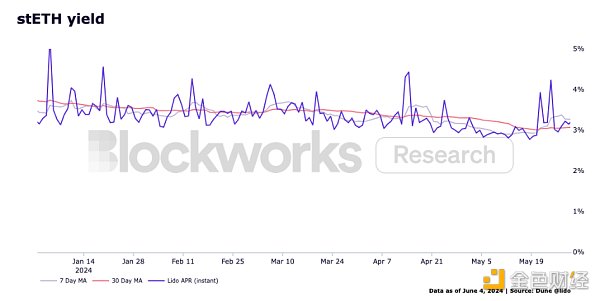
stETH rewards are a function of ETH issuance, priority fees, and MEV rewards. ETH issuance is a reward for validators participating in consensus and correctly proposing blocks. Currently, the issuance rate is 917,000 ETH per year (there is a discussion about changes in this monetary policy). Priority fees are paid by users to prioritize the inclusion of transactions. MEV rewards are an additional source of income for running MEV-Boost, which promotes the market by providing validators with a portion of Ethereum block rewards. This portion of the reward is calculated as a function of the demand for Ethereum block space. According to mevboost.pics, in 2023, validators realized approximately 308,649 ETH in revenue through MEV-Boost (equivalent to $70.43 billion using the ETH price on January 1, 2024). Taking these factors into account, investors can earn an annualized rate of return ranging from 3-4% during 2024 by simply holding stETH.
In summary, unlike the spot ETH ETF, stETH is a liquid product that allows investors to own ETH as an asset and obtain Ethereum's cash flow. In addition, stETH is also one of the most commonly used assets in various DeFi environments.
The key features that make stETH an ideal asset are liquidity and the ability to serve as collateral. Typically, it takes days to withdraw staked ETH because the time a staker has to wait to exit the queue depends on the size of the queue. This can lead to a duration mismatch situation, where the value of ETH changes dramatically between a withdrawal request and redemption.
stETH’s core value proposition is its liquidity. Stakers do not need to wait in an exit queue and can exit their staked position by simply listing stETH on a decentralized exchange (DEX) or centralized exchange (CEX). An astute reader will realize that eliminating the risk of duration mismatch shifts the risk to the willingness and ability of the secondary market to accept stETH inventory. Nonetheless, given the approval of the spot ETH ETF and the trends in the characteristics and underlying market structure of stETH, we can more than precedently expect further adoption of stETH and even deeper liquidity.
It is worth noting that in 2023, the amount of stETH reserves in liquidity pools on Ethereum and Rollups declined. This is because the DAO regulates the incentive payouts for on-chain stETH LPs, meaning that LPs that are primarily rewarded by mining LDO have withdrawn their reserves from the pool. By 2024, the reserves have stabilized. The shift from subsidized LPs (who are generally more inclined to withdraw reserves when they are most needed) to real, non-subsidized stETH LPs is healthier for stETH's on-chain liquidity landscape. Despite these market corrective forces, stETH remains one of the most liquid assets in DeFi and ranks in the top ten in TVL (total locked value) on Uniswap.

During the same time period, both stETH's trading volume and utilization in these pools have increased. The trends in the following charts indicate that:
Liquidity providers are more stable and consistent
The market liquidity for stETH has approached a more stable equilibrium
More and more participants are more accustomed to trading stETH
These market structures provide a stronger and more organic basis for expansion than overspending LDO incentive fees on seasonal liquidity providers. As shown in the figure below, stETH's trading volume and liquidity are clearly dominant compared to other liquid staking tokens (LST).
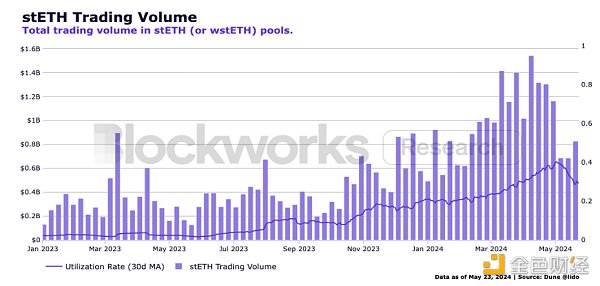
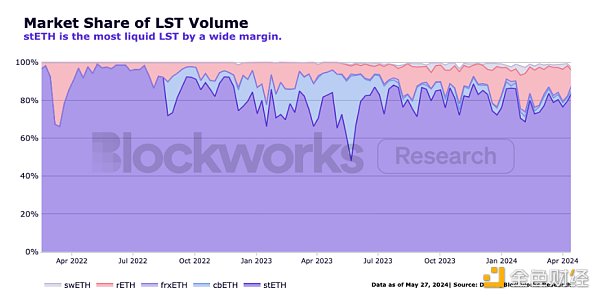
Liquidity is very important, and liquidity can be said to be the biggest determinant of risk management in financial markets. The liquidity status of an asset has a great impact on its risk-adjusted returns, and thus its attractiveness to investors. This makes stETH a better choice for investors and traders who want to earn Ethereum rewards, as demonstrated in a Blockworks panel discussion attended by large crypto-native institutions such as Hashnote, Copper, Deribit and Cumberland. The chart below shows the trend of crypto-native institutions adopting stETH on centralized trading platforms: More and more crypto-native institutions and market makers prefer to hold and trade stETH. Note: Due to the rate limit of order book data changed by the trading platform, the global bid data in February and March is partially incomplete.
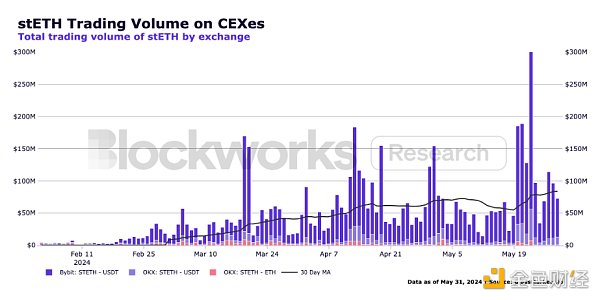
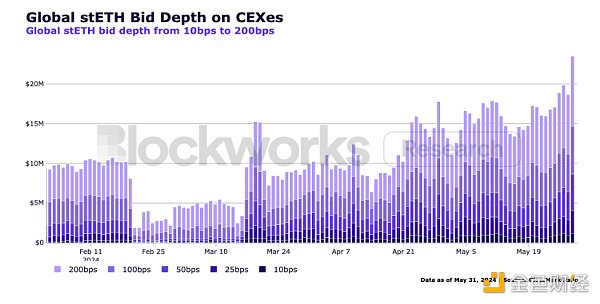
stETH is also the most popular collateral in DeFi, even surpassing ETH and popular stablecoins such as USDC, USDT, and DAI. The chart below shows that since its launch, it has gradually climbed to this position, accounting for about one-third of the total market share.
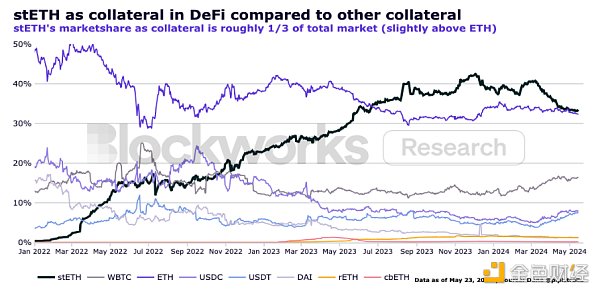
Having stETH as a high-quality collateral option makes it more capital efficient and may help trading platforms and borrowing platforms increase additional trading volume. In February of this year, Bybit announced that it would increase the collateral value of stETH from 75% to 90%. Since then, the volume of stETH transactions on Bybit has increased nearly 10 times.
It looks like the market structure of stETH on the chain has reached a more stable equilibrium point, which may lay a solid foundation for a gradual long-term growth trend. Off-chain, we can observe more signs of institutional adoption as investors prefer to choose pledged ETH instead of ordinary ETH. While we also expect other liquidity staking tokens (including potentially liquidity staking warrants) to gain market share, stETH's existing market structure and dominance, as well as first-mover advantage, should maintain its strong position in the market. In addition, Lido and stETH have some favorable characteristics compared to other staking options. Compared to other staking mechanisms, Lido's mechanism has three key characteristics: non-custodial, decentralized, and transparent.
Non-custodial: Neither Lido nor node operators will custody users' deposits. This feature mitigates counterparty risk, and node operators will never get hold of users' staked ETH.
Decentralized: No single organization verifies the protocol, and technical risks are evenly distributed among a group of node operators, improving resilience, availability, and rewards.
Open source: Anyone can review, audit, and/or propose improvements to run the protocol's code.
When comparing stETH to other Liquid Staking Tokens (LST) and staking service providers, the difference in rewards between the top node operators by total stake is small, ranging from about 3.3-3.5%, according to Rated data. However, considering the factors of operating a node, including operation and maintenance, cloud infrastructure, hardware, code maintenance, client type, geographical distribution, etc., the small difference in rewards contains a lot of risks.
stETH has lower risks because it ensures exposure to multiple operators who run different machines, codes, and clients in different locations and are managed by many teams. Therefore, the possibility of downtime is lower and the risk is more dispersed by default; while other staking service providers have more centralized operations and potential single points of failure. For more information on this field, Blockworks research analyst 0xpibblez wrote a detailed research report.
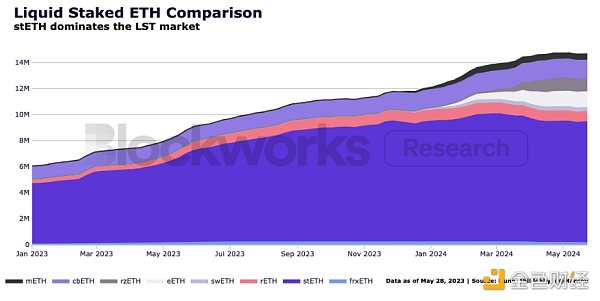
Referring to the first figure below, we can observe that the execution layer rewards (priority fees + baseline MEV) are more variable than the consensus layer rewards (issuance). The second figure below shows a zoomed-in view of this variation over the past month. This is due to the cyclical nature of on-chain activity, i.e., in certain periods, elevated activity levels coincide with more valuable blocks and therefore higher execution layer rewards; while consensus layer rewards are constant. This means that the realized staked ETH reward is a function of the probability that the validator proposes the next block, capturing the variability of the execution layer rewards.
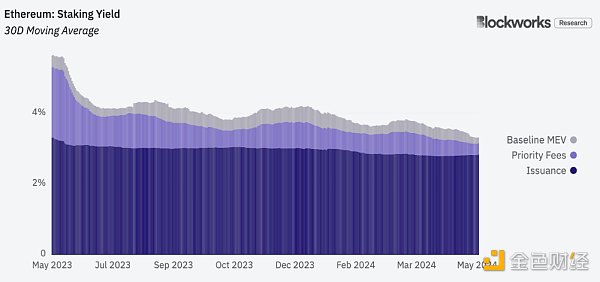
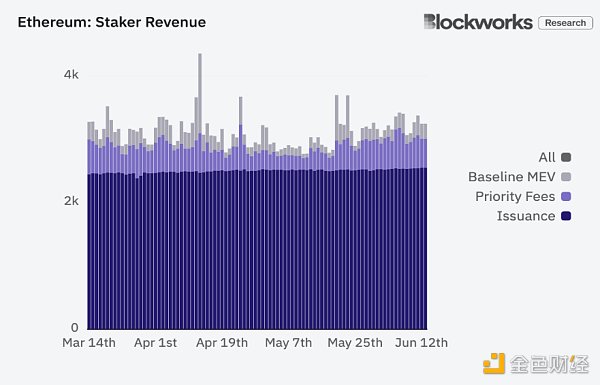
Since stETH is staked in a wide variety of operators and represents 29% of the total stake, stETH has a higher probability of capturing the variability of block rewards than independent validators, smaller operators, or validator sets with less stake. This means that it can always get a higher reward rate on average.
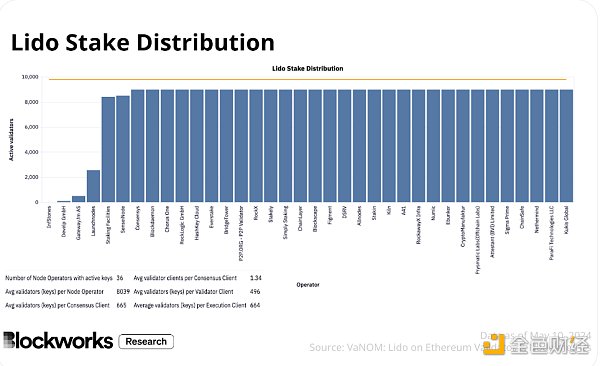
In other words, in the extreme case, when an independent validator proposes a very valuable block, even if the total return is much higher (for example, staking 32 ETH to earn 10 ETH in a block), the probability of this happening is very low, about one in a million (32/32,400,000). They basically won a lottery. On the other hand, Lido's validator set is more likely to capture valuable blocks, about 29% of the time. Therefore, users holding stETH choose and strengthen their chances of sharing more rewards.
In summary, another reason why stETH is a superior choice for obtaining exposure to staked ETH rewards is that it produces highly competitive rewards on a probability and risk-adjusted basis.
The approval of the spot ETH ETF brings expectations for additional products, the most obvious of which is the pledged ETH product. During his bull cycle rest period, crypto native legend DegenSpartan wrote a post titled "How Many Trojan Horses Can We Launch?" In this short blog post, DegenSpartan wrote: "After the spot ETF, we can still expect more access in the [traditional finance] field, options, inclusion in fund portfolios, mutual funds, retirement accounts, fixed investment plans, structured products, dual currencies, Lambad loans, etc."
While the U.S. capital market will have more exposure to ETH and bring more permanent (structural) winds, it is not clear how traditional finance can integrate other digital assets or derivatives and their possible side effects on decentralization.
Philosophically, we believe that LST is the best way to maintain a sufficiently decentralized, secure, and high-performance set of validator nodes. Grandjean et al. calculated Ethereum's HHI index (an indicator of market concentration and competitiveness) and found that Lido has improved decentralization (as shown by the lower HHI reading in the figure below).
While treating Lido as an entity results in a higher HHI (i.e., the network is less decentralized), we do not believe that this description of Lido accurately reflects Lido's presence in the market because the protocol is not managed or controlled by one organization or entity, and the validator node set consists of a variety of independent separate entities. While there are risks with large LSPs (staking service providers), the implementation of appropriate governance mechanisms and protocol supervision, such as dual governance, should mitigate their severity. In addition, it is expected that the addition of DVT will further decentralize the operator set.
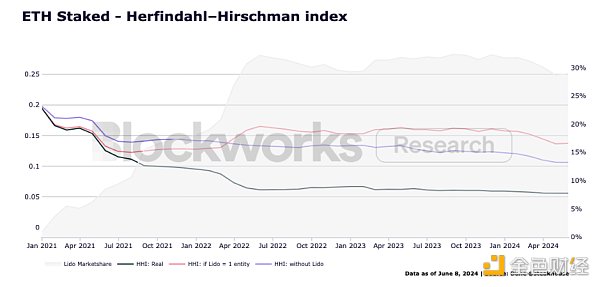
That being said, given the economic incentives of staking ETH, or the dilution of holding native ETH, it is possible that traditional finance will eventually offer staking ETH products. Some possible (purely) hypothetical outcomes include:
Traditional finance explicitly adopts stETH and all its benefits
Traditional finance works closely with Coinbase or other large institutional staking service providers to establish this framework, in which cbETH or tradfiETH becomes the official staking ETH product of traditional finance
Traditional finance develops its own practices, invests in proprietary node operations, hosts its own staking ETH, and issues tradfiETH products.
“While this is all well and good for BTC [and ETH], the future is somewhat unknown.” - DegenSpartan
We believe, and have evidence to suggest, that (1) is the better solution for the network from a hypothetical scenario, because in any case, if staking ETH moves in the direction of traditional financial ETH, the staking risk on the chain will tend to be centralized. Therefore, in the case of highly capitalized existing players developing centralized staking products, as long as Lido remains sufficiently decentralized, both stETH and the DAO are key factors in maintaining the overall consistency of Ethereum, because the DAO manages the delegation of stETH and indirectly affects the performance, security, and decentralization of the network.
Volatility and Liquidity: When ETH volatility surges, investors prefer to sell stETH on the open market rather than waiting in the withdrawal queue. During periods of high volatility, high sales volumes could cause the price of stETH to deviate from its 1:1 price peg with ETH if there is not enough liquidity, which presents subsequent risks until market conditions recover.
Circulation Risk: A common method of earning rewards (e.g. participating in airdrops or liquidity mining incentives) where users take a leveraged position, lend stETH, borrow ETH, buy stETH, lend additional stETH, and repeat the cycle until they are fully leveraged to capacity. During periods of volatility, loopers are at risk of being liquidated, which could trigger amplified risks associated with volatility and liquidity.
Protocol and Governance: Risks associated with LSPs capturing a significant market share. The protocol to which stETH is delegated is governed by a DAO. While the DAO is taking steps toward dual governance, which would reduce these risks, concerns about the concentration of ETH shares in LDO governance are warranted if stETH captures a majority of the staked ETH.
Smart Contracts: The Lido protocol is executed by a series of smart contracts. This includes deposits, withdrawals, delegated staking, penalties, and key management. There are unanticipated bugs or malicious upgrades associated with smart contracts in these systems.
Competitors: The LST market is large, and there are more re-staking protocols entering the competitive field. Traditional finance also has the ability to develop its own staking products, which may be more accessible to some investors given the current market structure.
Regulation: Although the approval of spot ETH ETFs may make staking service providers safer on average, staking ETH will still be subject to regulatory scrutiny. Relevant legal discussions include (but are not limited to) the role of staking service providers, the distinction between "management" and "administration" under the Howey test, and whether LSPs are "issuers" (under the Reve test).
By today's standards, stETH is arguably the product with the best participation in staking ETH. It is the most liquid LST on-chain, the most widely used form of collateral in DeFi, and these market structures are rapidly expanding off-chain, as evidenced by volume growth on exchanges, particularly ByBit and OKX.
While there are risks to holding stETH, these strong market structures are likely to continue and could expand further driven by the properties of stETH, Lido’s protocol, the growing need for Ethereum’s overall consistency, and upcoming catalysts. These catalysts on the roadmap include Distributed Validator Technology (DVT), dual governance, supporting pre-confirmations and allocating additional resources for re-staking stETH, and an improved governance structure that will help Ethereum research. More importantly, if traditional finance develops collateralized ETH products, stETH and LidoDAO will play an increasingly important role in the broader context of Ethereum.
As TradFi seeks staking ETH rewards, this could mean developing a “tradfiETH” product, with stETH serving as a coordination tool to combat centralization.
 JinseFinance
JinseFinanceCollapsed cryptocurrency lending platform Celsius has announced that it will withdraw $1.6 billion worth of Ethereum it had previously staked on the chain.
 JinseFinance
JinseFinanceThe move mirrors that of Binance, the world's largest crypto exchange, in terms of leaving Canada.
 Others
OthersThis latest approval highlights Bybit's continued commitment to expanding its presence in emerging and dynamic markets.
 Others
OthersBybit and Swyftx are the latest victims of the spreading crypto contagion, with both firms announcing job cuts in the wake of FTX collapse.“
 decrypt
decryptBybit is the latest crypto exchange to slash a sizeable portion of its workforce.
 Others
OthersHuobi and Bybit have publicly provided their proof of reserves to assure investors.
 Beincrypto
Beincrypto"Bybit responded to the OSC’s enforcement action, maintained an open dialogue, provided requested information, and committed to engaging in registration discussions," said the OSC.
 Cointelegraph
Cointelegraph Nulltx
NulltxThe function enables users to speculate on future prices of cryptos and settle their trades using USDC.
 Cointelegraph
Cointelegraph